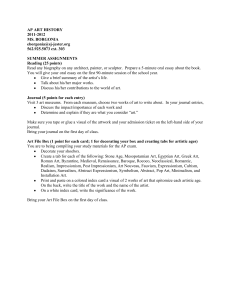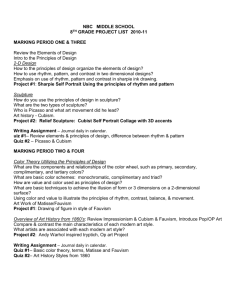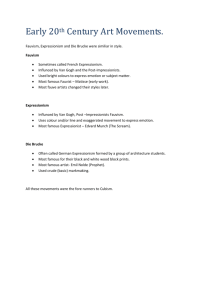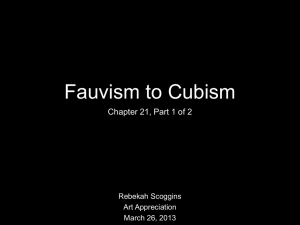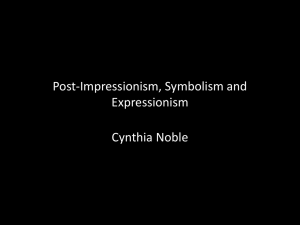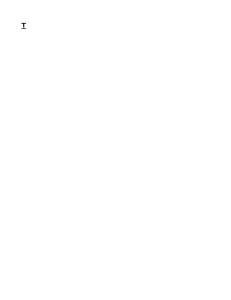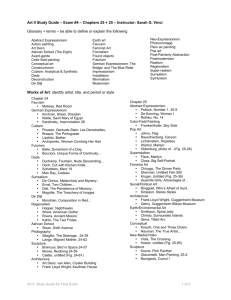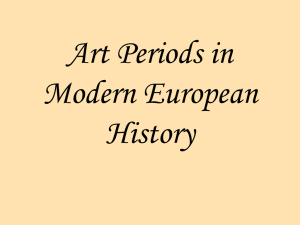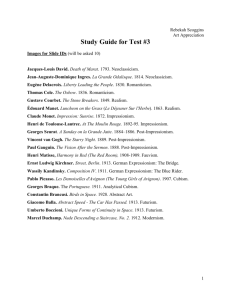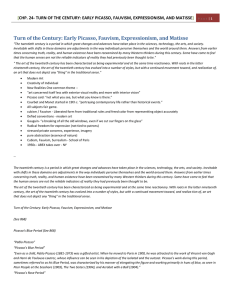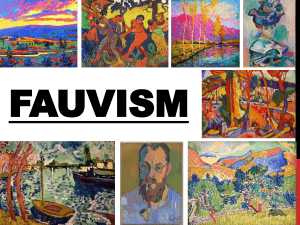Turn of the Century: Early Picasso, Fauvism, Expressionism, and
advertisement
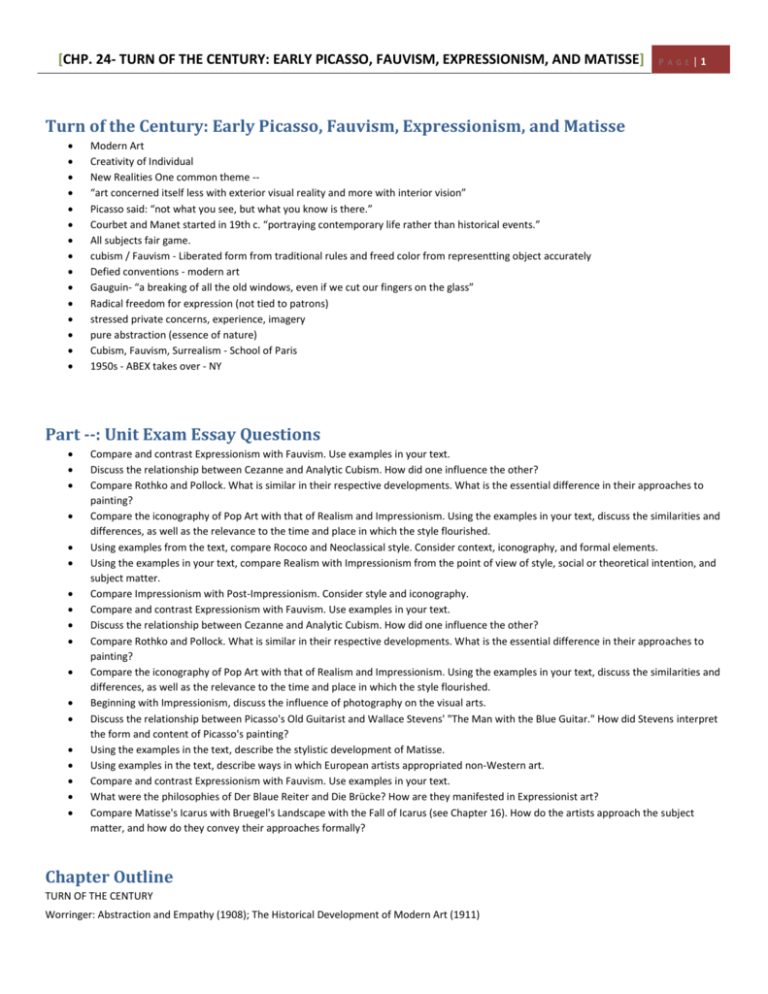
[CHP. 24- TURN OF THE CENTURY: EARLY PICASSO, FAUVISM, EXPRESSIONISM, AND MATISSE] P A G E |1 Turn of the Century: Early Picasso, Fauvism, Expressionism, and Matisse Modern Art Creativity of Individual New Realities One common theme -“art concerned itself less with exterior visual reality and more with interior vision” Picasso said: “not what you see, but what you know is there.” Courbet and Manet started in 19th c. “portraying contemporary life rather than historical events.” All subjects fair game. cubism / Fauvism - Liberated form from traditional rules and freed color from representting object accurately Defied conventions - modern art Gauguin- “a breaking of all the old windows, even if we cut our fingers on the glass” Radical freedom for expression (not tied to patrons) stressed private concerns, experience, imagery pure abstraction (essence of nature) Cubism, Fauvism, Surrealism - School of Paris 1950s - ABEX takes over - NY Part --: Unit Exam Essay Questions Compare and contrast Expressionism with Fauvism. Use examples in your text. Discuss the relationship between Cezanne and Analytic Cubism. How did one influence the other? Compare Rothko and Pollock. What is similar in their respective developments. What is the essential difference in their approaches to painting? Compare the iconography of Pop Art with that of Realism and Impressionism. Using the examples in your text, discuss the similarities and differences, as well as the relevance to the time and place in which the style flourished. Using examples from the text, compare Rococo and Neoclassical style. Consider context, iconography, and formal elements. Using the examples in your text, compare Realism with Impressionism from the point of view of style, social or theoretical intention, and subject matter. Compare Impressionism with Post-Impressionism. Consider style and iconography. Compare and contrast Expressionism with Fauvism. Use examples in your text. Discuss the relationship between Cezanne and Analytic Cubism. How did one influence the other? Compare Rothko and Pollock. What is similar in their respective developments. What is the essential difference in their approaches to painting? Compare the iconography of Pop Art with that of Realism and Impressionism. Using the examples in your text, discuss the similarities and differences, as well as the relevance to the time and place in which the style flourished. Beginning with Impressionism, discuss the influence of photography on the visual arts. Discuss the relationship between Picasso's Old Guitarist and Wallace Stevens' "The Man with the Blue Guitar." How did Stevens interpret the form and content of Picasso's painting? Using the examples in the text, describe the stylistic development of Matisse. Using examples in the text, describe ways in which European artists appropriated non-Western art. Compare and contrast Expressionism with Fauvism. Use examples in your text. What were the philosophies of Der Blaue Reiter and Die Brücke? How are they manifested in Expressionist art? Compare Matisse's Icarus with Bruegel's Landscape with the Fall of Icarus (see Chapter 16). How do the artists approach the subject matter, and how do they convey their approaches formally? Chapter Outline TURN OF THE CENTURY Worringer: Abstraction and Empathy (1908); The Historical Development of Modern Art (1911) [CHP. 24- TURN OF THE CENTURY: EARLY PICASSO, FAUVISM, EXPRESSIONISM, AND MATISSE] P A G E |2 Wöfflin: The Principles of Art History (1915) Technology advances; Russian Revolution (1917) Picasso's Blue Period; Matisse's Fauvism Expressionism in Germany The Bridge: Kirchner; Nolde The Blue Rider: Kandinsky; Marc Kollwitz Matisse after Fauvism; collage African Art and the European Avant-Garde Summary and Study Guide American and European Art 1800‐1900 Realism, Impressionism, Post‐Impressionism, Symbolism, and More! (AP Art History) Art Works know these works by sight, title, date, medium, scale, and location (original location also if moved) and be able to explain and analyze these in relation to any concept, term, element, or principle. German Expressionism (c. 1910-1930) he Bridge, The Blue Rider Strong color Linear pattern Emotional subjects Powerful Intense Artists experimented with media and invented new forms while retaining their uniqueness and individuality. They found in primitive art a spontaneity, energy, and design that affected their expressions. Expressionism: first group gathered in Dresden 1905 Leader--Kirchner Die Bruecke: “The Bridge” between old and new concern for stress-filled conditions of modern life in Germany before WWI infl. Van Gogh, Muench, Fauves, primitive harsh color, distortions injustices of society, evils union of nature and humans steep perspective, angular forms, haunted people expressed inner coruption Early twentieth-century expressionist painting is represented by groups of well-organized German and Dutch artists who combined formal aspects of the Fauve and Symbolist movements, always with an intense interest in color and pure design. The most prominent Expressionist groups included: Die Brucke (The Bridge) Ernst Kirchner (1880-1938) Emil Nolde (1867-1956) Käthe Kollwitz (1867-1945) [CHP. 24- TURN OF THE CENTURY: EARLY PICASSO, FAUVISM, EXPRESSIONISM, AND MATISSE] Der Blaue Reiter (The Blue Horseman) Wassily Kandinsky (1866-1944) Franz Marc (1880-1916) Paul Klee (1879-1940) Lyonel Feininger (1871-1956) Oskar Kokoschka (1886-1980) Max Beckman (1884-1950) Other Key German Expressionists George Grosz (1893-1959) P A G E |3
